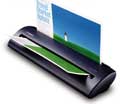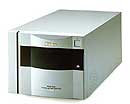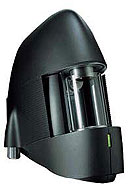Scanners - the Ultimate Guide
Scanners gradually become an integral accessory
for PC. According to the forecasts of market analysts, soon up to
10% PC will be sold in a complete set with a scanner. The reasons
for such explosive growth are obvious: decrease of the scanners' prices,
availability of special software for automation of the document circulation
(scan -> OCR -> archive -> fax/e-mail), dramatic fall of
the prices on ink-jet and photo printers, and, at last, Internet and
e-mail, which made transfer of the images and graphic files very cheap
and fast.
Certainly, these market opportunities could not
be unnoticed. If in the beginning of 90's manufacturers of scanners
have been presented by just a few niche companies, now in assembly
of scanners have engaged all who is not too lazy, including Taiwanese
firms, whose basic business was trade of the real estate. As the result,
decrease of the prices (and as side effect - quality), plus five large
manufacturers exited from the game.
I could not specify precise market share figures
(in fact, nobody can), but currently biggest scanner manufacturers
are UMAX, Mustek, HP, Microtek, Plustek and Primax. In fact, market
share figures depend on certain calculation methods. It is not completly
clear to whose market share belonging so called OEM scanners, assembled
by one company but sold under the trademark of another. So, for example,
scanners from Agfa and Polaroid are manufactured by Microtek, while
UMAX produces some models for HP and Heidelberg. By the way, the information
about OEM contracts usually is not widely published because of purely
marketing reasons.
Classification
By underlying technology scanners can be divided
on sheetfeed (around $100); flatbed
(under $100 - $75,000) for widest range of tasks (described in depth
on next page), slide-scanners
(under $500 - $10,000); and drum
scanners ($15,000 - $100,000). Apart from those there are pen
scanners, used for text input; card
scanners; bar-code scanners (possibly
do not need to be explained); handheld
scanners, once dominated the consumer market until prices of flatbed
scanners become acceptable for majority of users (I am not sure if
handheld scanners are still manufactured); and wide-format
(A1 - A0) scanners, used mostly in engineering. Additionally, some
companies developed proprietary scanning technologies (for example,
Imacon invented technology called "virtual
drum").
Sheetfeed Scanners
 The
sheetfeed scanners in most cases are suited for document scanning
only because of use of contact image censors (CIS) which produce poor
color quality (compared to good CCD based flatbeds). One more drawback
of these devices is impossibility of scanning of the books and the
magazines - pages should be cut out. Visually they looking much like
ink-jet printers. Firstly released by UMAX back in 1994, but UMAX
failed to market them. Right now most famous brand of sheetfeed scanners
- Visioneer, mostly because of proper marketing and excellent software
package.
The
sheetfeed scanners in most cases are suited for document scanning
only because of use of contact image censors (CIS) which produce poor
color quality (compared to good CCD based flatbeds). One more drawback
of these devices is impossibility of scanning of the books and the
magazines - pages should be cut out. Visually they looking much like
ink-jet printers. Firstly released by UMAX back in 1994, but UMAX
failed to market them. Right now most famous brand of sheetfeed scanners
- Visioneer, mostly because of proper marketing and excellent software
package.
Wide Format Scanners
 Wide
format scanners resemble sheetfeed ones grown to behemoth size. Construction
of both is very similar. These devices may work with flexible and/or
rigid 90 - 120 mm width originals, usually of unlimited length and
maximal thickness around 3 - 12 mm. Used to scan engineering drawings,
maps, and posters. Manufactured (or sold as re-branded OEM equipment)
by Contex, Vidar (these two companies merged together), IDEAL, Oce
and Jumboscan.
Wide
format scanners resemble sheetfeed ones grown to behemoth size. Construction
of both is very similar. These devices may work with flexible and/or
rigid 90 - 120 mm width originals, usually of unlimited length and
maximal thickness around 3 - 12 mm. Used to scan engineering drawings,
maps, and posters. Manufactured (or sold as re-branded OEM equipment)
by Contex, Vidar (these two companies merged together), IDEAL, Oce
and Jumboscan.
Card Scanners
 These
handy devices are designed to simplify tedious task of reading and
recording information from business cards. Usability of card scanners
determined by bundled software capabilities by 80%, if not even more.
OCR software have to be very intelligent to recognize different layouts
of business cards and properly identify scanned data (organization,
contact person, phone#, fax#, e-mail, company WEB site URL). Additionally,
ability to link and export acquired information to database or contact
management system is essential. Some software like CardScan bundled
with frame holder for several business cards and can work with conventional
flatbed scanner. Card scanners currently marketed by Corex Technologies,
I.R.I.S and Targus.
These
handy devices are designed to simplify tedious task of reading and
recording information from business cards. Usability of card scanners
determined by bundled software capabilities by 80%, if not even more.
OCR software have to be very intelligent to recognize different layouts
of business cards and properly identify scanned data (organization,
contact person, phone#, fax#, e-mail, company WEB site URL). Additionally,
ability to link and export acquired information to database or contact
management system is essential. Some software like CardScan bundled
with frame holder for several business cards and can work with conventional
flatbed scanner. Card scanners currently marketed by Corex Technologies,
I.R.I.S and Targus.
Pen Scanners
 Pen
(or pen-sized) scanners used to enter data directly to any application.
Depending on the bundled software, pen scanners are capable to acquire
plain text, bar-codes and even handwritten text. Pen scanners sold
by I.R.I.S., I am not aware if
anyone else exist in this market.
Pen
(or pen-sized) scanners used to enter data directly to any application.
Depending on the bundled software, pen scanners are capable to acquire
plain text, bar-codes and even handwritten text. Pen scanners sold
by I.R.I.S., I am not aware if
anyone else exist in this market.
Slide Scanners
 The
name of slide scanners is not absolutely exact - in most cases they
are used to scan 35-mm film negatives. When scanning 35-mm negatives
and slides these scanners have a number of advantages over their flatbed
counterparts: first, the slide scanner which costs $1500 - $2000 will
ensure at least the same degree of quality as the flatbed priced at
$5000; second - slide scanner is much faster and easier to use for
batch scanning. A drawback of slide scanners is limited sphere of
use - devices of this category cheaper than $4,000 can not scan anything
except 35-mm film. Some slide scanners which price is around $7,000
- $10,000 can accept big slides and offer really good quality, but
for roughly the same price its possible to buy flatbed which can scan
everything.
The
name of slide scanners is not absolutely exact - in most cases they
are used to scan 35-mm film negatives. When scanning 35-mm negatives
and slides these scanners have a number of advantages over their flatbed
counterparts: first, the slide scanner which costs $1500 - $2000 will
ensure at least the same degree of quality as the flatbed priced at
$5000; second - slide scanner is much faster and easier to use for
batch scanning. A drawback of slide scanners is limited sphere of
use - devices of this category cheaper than $4,000 can not scan anything
except 35-mm film. Some slide scanners which price is around $7,000
- $10,000 can accept big slides and offer really good quality, but
for roughly the same price its possible to buy flatbed which can scan
everything.
Many slide scanners (with the price tag around
$500 and above) are bundled with software for automatic removal of
scratches, dust and fingerprints (to be honest, sometimes it works,
sometimes not). One of the most effective and widely used called Digital
ICE (Image Correction Enhancements).. The idea behind this
technology is to use additional infrared light beam, which can pass
through the film's emulsion but cannot pass through the dust and scratches.
This will allow to create map of defects, which will be subtracted
from the resulting scan. Missing pieces of final image are regenerated
using interpolation. Please note that Digital ICE does not work with
the black&white film.
Another useful feature which should be present
for slide scanners with resolution 3000 dpi and above - removal of
film grain from scanned image. It may be sold using different names
trademarks, so just look in the manual.
Slide scanners sold by Canon, Epson, Microtek,
Minolta, Nikon, Polaroid, UMAX. Polaroid slide scanners are manufactured
by Microtek, I have no other OEM related information about other mentioned
above brands.
Drum Scanners
 The
drum-type scanners are used only by high-end graphic and photo professionals.
The original is mounted with gluey ribbon on a glass drum (that is
where their name comes from), which rotates on a spiral-like trajectory
("is screwed"). A special type of optical censor - vacuum
photo multiplier tube (PMT) is used to capture image and is characterized
by very low level of noise and distortions. One turn of drum is necessary
for capturing one line of pixels, so scanning speed of these devices
is relatively measured by number of revolutions per minute (RPM).
Drum scanners allow to achieve unsurpassed image quality, but they
are very expensive (at least $15,000 for hardware and $1,500 - $2,500
for software) and inconvenient. Recently drum scanners have faced
extremely tough competition from the side of professional flatbed
and virtual drum scanners, which characteristics almost closed the
image quality gap. Currently drum scanners are available from Crossfield,
Eurocore, Heidelberg, Optronics, Purup-Escofot/ScanView, Screen and
some others.
The
drum-type scanners are used only by high-end graphic and photo professionals.
The original is mounted with gluey ribbon on a glass drum (that is
where their name comes from), which rotates on a spiral-like trajectory
("is screwed"). A special type of optical censor - vacuum
photo multiplier tube (PMT) is used to capture image and is characterized
by very low level of noise and distortions. One turn of drum is necessary
for capturing one line of pixels, so scanning speed of these devices
is relatively measured by number of revolutions per minute (RPM).
Drum scanners allow to achieve unsurpassed image quality, but they
are very expensive (at least $15,000 for hardware and $1,500 - $2,500
for software) and inconvenient. Recently drum scanners have faced
extremely tough competition from the side of professional flatbed
and virtual drum scanners, which characteristics almost closed the
image quality gap. Currently drum scanners are available from Crossfield,
Eurocore, Heidelberg, Optronics, Purup-Escofot/ScanView, Screen and
some others.
Virtual Drum Scanners
 This
outstanding scanning technology developed and patented by Imacon (now
branch of Glunz&Jensen). The flexible original is held by magnetic
radius curved holder which rotates like a drum of a drum scanner.
The light directly passes through film to the variable focus optical
system with CCD sensor. Additionally, film do not need to be mounted
on the glass surface (like drum scanners) or in frame holder (like
flatbeds). Flexible holder and smart carrier system makes mounting
a few seconds process. All these innovation allowed to eliminate problems
associated with conventional drum and flatbed scanners: Newton rings,
loss of quality caused by mirrors and extra glass plates, tedious
mounting of originals, possible damage of sensitive film, etc. The
productivity speed of virtual drum scanners is limited to around 15
scans per hour. However, innovative technology plagues by awkward
software - results after scanning of negatives often are really odd.
This
outstanding scanning technology developed and patented by Imacon (now
branch of Glunz&Jensen). The flexible original is held by magnetic
radius curved holder which rotates like a drum of a drum scanner.
The light directly passes through film to the variable focus optical
system with CCD sensor. Additionally, film do not need to be mounted
on the glass surface (like drum scanners) or in frame holder (like
flatbeds). Flexible holder and smart carrier system makes mounting
a few seconds process. All these innovation allowed to eliminate problems
associated with conventional drum and flatbed scanners: Newton rings,
loss of quality caused by mirrors and extra glass plates, tedious
mounting of originals, possible damage of sensitive film, etc. The
productivity speed of virtual drum scanners is limited to around 15
scans per hour. However, innovative technology plagues by awkward
software - results after scanning of negatives often are really odd.
Continued - flatbed
scanners in depth...

